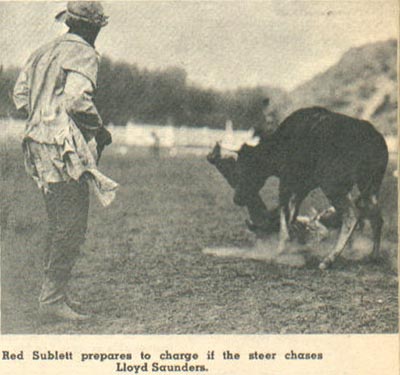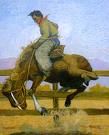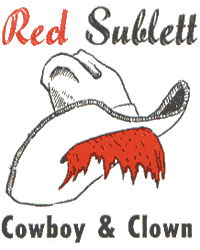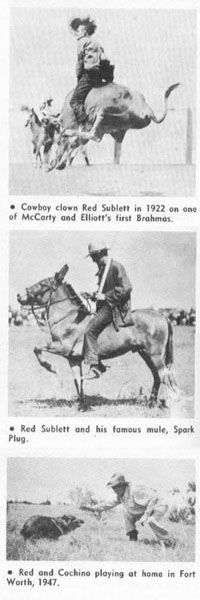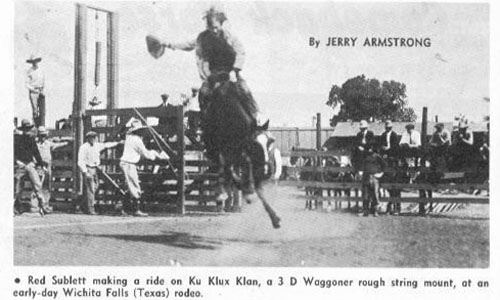Sublett.org |
||||
|
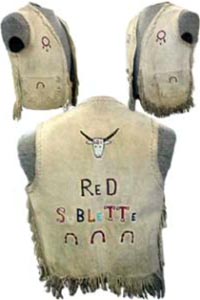
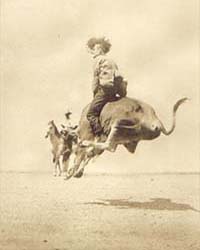
|
Red Sublett, Cowboy Clown
By Stew Bean"Hoofs and Horns" Vol. XXIII, No. 10
April, 1954
Today in the arena you frequently see a baggy-pants clown pull a comical bit of nonsense for laughs -- in many cases the comical bit of nonsense was first pulled, in the same arena, 30 years ago by the late Red Sublett. The antics of Sublett and a handfull of other earlier day rodeo buffoons must have been good for they have survived the trial of time. The advent of the Brahma came after most of the pioneer rodeo comics were through. Sublett, however, had much experience with them. He was riding and clowning with Brahmas in Texas, and then elsewhere for McCarty and Elliott, at a time when the hump-backed bovines were an unknown nemesis in other parts of the country. Sublett's spectacular set-tos were an inspiration to many youngsters who later cut themselves a slice of fame and fortune in rodeo. Red Sublett was a broth of a boy and born too soon. It should have been so that he could be clowning today -- in rodeo's heyday.
Red Sublett was born in Arlington, Texas, and shortly thereafter the family made what was then a long trek, from Arlington to Tishomingo, Oklahoma (then Indian Territory). Mother, father and seven children traveled in a horse-drawn covered wagon. Two haltered milk cows plodded along behind the wagon, assuring the family of an ample and ever-fresh milk supply. In Indian Territory, Senior Sublett ran a plantation for one Ben Colbert. Later he was appointed a United States marshal. The country and many of its inhabitants were on the wild and woolly side. At Mill Creek, in a gun fight with outlaws, Marshal Sublett's left hand was shot off. Shortly after this episode Red, who was then about 10 years old, left home to reside with an uncle at "Sublett," Texas (named for Red's paternal grandfather). Here he attended school and got in much riding and roping practice. At 16 he returned to Oklahoma and there joined Booger Red's traveling cowboy show.
Young Sublett left Booger Red to work cattle and ride the rough string on Burk Burnett's Four Sixes ranch out of Panhandle, Texas. Later, he rode for the LX on the Canadian for the 101, out of Bliss, Oklahoma, and the JY out of Amarillo and Truscott, Texas. Being at this time a talented rider of rough stock and an adept trainer who could turn a green colt into a working cowhorse, Red became a traveling horse trainer and rough string rider. He traveled far and saw much in the ensuing years.
In 1917, in Fort Worth, he joined Lucille Mulhall's show. Here he rode broncs and steers and for variety and to help at the gate he would avowedly mount anything that could be dragged, pulled or pushed into the arena. He racked up rides on buffalo, zebras, mules and ostriches. During this period, Red rode his first freight train (he was broke) and his first steamboat, on the Mississippi (he was no longer broke). Then he hung up his rig, sacked his gear and paraphernalia and joined the Army. He went overseas with the 90th Division and saw no little action on the battlefields of France. The two-gun marshal's son here proved to be "a chip off the old block." When the war ended and the boys were discharged, Red promptly returned to the Southwest and rodeo arenas.
He was contesting and putting on clowning exhibition rides on rough stock when Tex Austin, the producer (whom Red called the "Daddy of Rodeo") and Fog Horn Clancy, the announcer, discovered him. Red was in the big time. For years he was rodeo's number one cowboy clown and annually worked all the big time shows in America and in Canada. He went to London, for Tex Austin's Wembley Stadium Rodeo, to Paris to clown Tommy Kirnan's show; to Mexico City; Brussels; Dublin, Ireland, and to Hollywood and the movies. His biggest rodeo payoff, and they were all big for Sublett in those days, was the $4,000, with all expenses paid, that he received for clowning the 6-day Dublin show.
Red had a trained mule, buckskin in color and Sparkplug by name, that he used in his rodeo clowning routines. Sparkplug came to be almost as renowned in rodeo as was his master. The little mule was a canny performer and probably at his best when imitating a trained horse act booked to work the same show. While the superbly trained horse would be going through an act of intricate tricks and startling poses in front of the grandstand, near by little Sparkplug, under Red's cuing, would be doing the exact same routine with a few extra flourishes thrown in for good measure and for laughs.
Sparkplug passed away in Fort Worth, Texas, in 1931. The fabulous redhead, the old Tishomingo Kid who went from riding the rough string to entertaining royalty and you and me (if you are old enough) passed away in the Veterans Hospital, Dallas, Texas, on April 14, 1950.
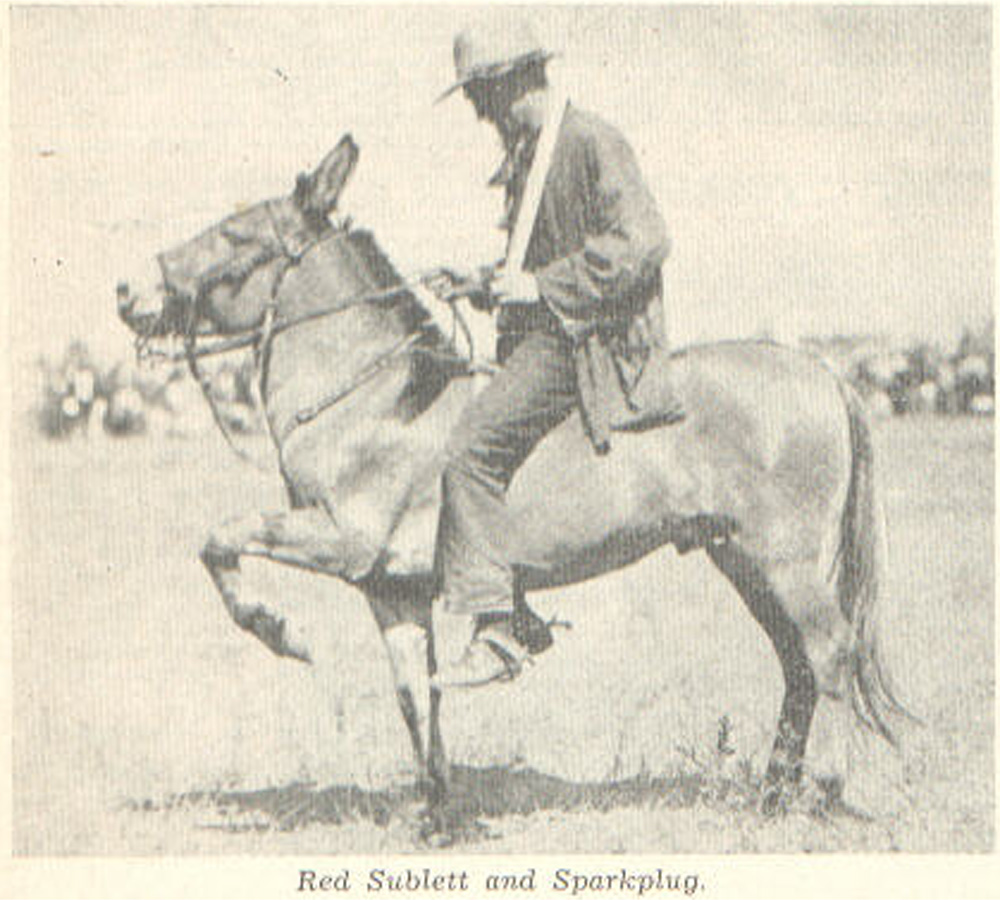
From VirtualTexan.com:
Historical sites remind current residents about area's rich past
By Lizabeth CardenasFort Worth Star-Telegram
February 28, 1999 ... Stairway to Heaven -- One of Northeast Tarrant County's more unusual landmarks revolves around a concrete spiral stairway, which was constructed in the center of a one-story house on North Beach Street in Haltom City. The house burned a number of years ago, and a commercial warehouse stands on the property now. The stairway spiraled up past the first floor until it came to a stop in the air -- leading to nothingness. The flat-roofed house was said to belong to Red Sublett, a rodeo clown. His wife, Venita Hahn, thought herself to be a general in the Army for New Jerusalem, and built the stairway to heaven. ...
Red Sublette appears at the Tucson Rodeo
Arizona Daily StarFebruary 21, 1925
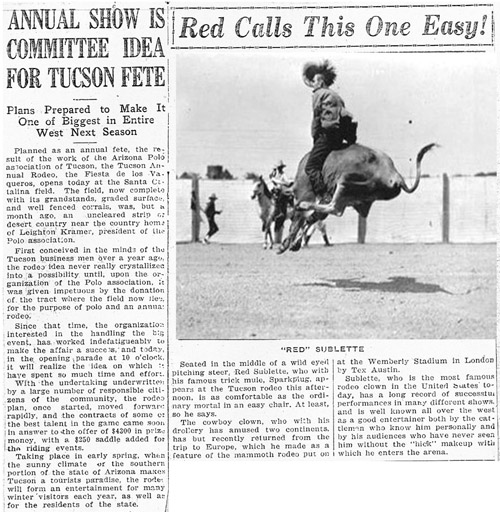
From Frontier Times magazine:
Life of a Rodeo Clown
Obscured by those long suspenders and baggy pants is a lot of horsemanship -- cowboy savvy -- and courage which perhaps only his fellow performers can truly appreciate ...
"Frontier Times" Vol. 40, No. 5
August-September, 1966
I was a clown when rodeo was in its infancy. The very first clowns I knew and worked with were the great Dan Dix, Bill Carris and Joe Lewis; also the one and only Billy Lorette. Dan Dix featured his good trick mule, Virgil. Dix also used him in the trick riding events. Dix did not wear any make-up whatsoever. He wore a flat hat.
Bill Carris dressed as a policeman and wore the old-timey policeman's round top hat. He had a big star on his coat and carried a police stick. He featured a donkey, calling it his "singing Canary." And sing he did. When he was told to sing he would bray, backing his ears and raising his tail up and down.
Billy Lorette Needed not one thing to help him sell himself. He made the people and kids laugh. He worked as a policeman, wore a cap, and his hair hung half-way down his neck. He did a lot of pantomime, but he could also talk. Lorette was a natural clown -- people would laugh just to look at him. He was with the 101 Show until it closed. He died in Chicago in the late Thirties -- the greatest of all clown cops.
Joe Lewis was also a clown policeman. He had a mule and worked as a Jewish cop.
The next clown I worked with was the great Cy Perkins whom I met on the Col. Zak Mulhall Wild West Show. The year was 1915 when we played the Oil Boom Days in Texas and Oklahoma. He dressed as a country rube, with a linen duster and bald wig. He used no props.
No one knows whatever became of him. He just disappeared from the show and I was asked by Lucille Mulhall, the daughter of Col. Zack, if I would clown in his place. So I did.
I got a linen duster, the biggest I could buy, ordered a bald wig, and sewed into the pocket of the duster the biggest red bandana handkerchief I could buy. I named myself CY 71, as 71 was always my lucky number.
They say I made good. Mulhall used big cattle. His dogging steers were big ones; his bucking steers were big and hard to ride. And three or four of them sure were good fighting steers. We used two-handhold surcingles in those days. The Mulhalls also had some real bucking horses.
I am sure that chutes were used for the first time here. The Colonel and I got our heads together and he, I and Slim Cassidy built one straight-away chute with gate open to the front. It was at Wirt, Oklahoma (they then called it Ragtown). I remember it well, as it was here one night that I had quite an experience. I was about to come out of the chute on this big steer called Death Valley and had just pulled my duster out from under me -- the gate was ready to swing open -- when Col. Mulhall pulled his bottle of Highlife and put a little on the steer's rump. The rest in the bottle he let go down the seat of my pants!
The gate was then opened and of all the wild rides -- I made it. The old steer bucked and bawled and kicked. Well, that steer and I sure did please the people. They got a big thrill when the steer unseated me on the ground. He charged me, rolling me over and over with his horns (big brass harness knobs were on each horn).
In some way I managed to get up and did I run to the fence! I got on top of the fence post, and cut a few monkey shines. The people went wild. When I cooled off, I got down and walked to the chutes where Col. Mulhall was standing.
I said, "Colonel, you are an old man, white-headed, a lot older than I. But I am going to pour a whole bottle of that stuff down your pants, or give you a damn good licking."
At this Lucille rode up and said, "Milt, please don't hurt Daddy. He must not have known what he was doing."
Slim Cassidy, a big man -- 6 feet 3 inches, about 190 pounds -- said, "Come on, Colonel," and said to me, "Don't do anything you will be sorry for, as I will have to take the old man's part."
Well, at this I said, "All right, Slim." That would have been one hell of a fight, as we both were in good shape after wrestling these big steers up to five minutes.
The Colonel then put out his hand and said, "Milt, I was just having fun. Tell you what you do -- that steer sure rolled you over and over and if his horns hadn't had those knobs on them, you wouldn't be here. We have some steers without knobs, so you just clown and keep them off my cowboys."
This was in the year 1915, and I think it was the first time a clown was used for this purpose.
The next night there was more excitement for the folks. Red Harrington, a real good bucking horse rider, was riding Hamburger Bill, a big gray. Poor Red got bucked off, and his left foot hung up in the stirrup. Hamburger Bill started running around the arena and struck Red's head on the fence post.
I was riding Lucille's big steer roping horse to help pick up. I rode fast to the head of the bucking horse. I don't remember this but they said I jumped from my saddle onto the running horse's head, grabbed the halter and put my right hand over the horse's nose. At this the horse crippled and fell.
When he hit the ground, big Slim Cassidy was on him holding to the saddle horn, holding him down. Then Red Sublett cut the stirrup leather, releasing Red. Curly Griffith and some others dragged Red away from the horse, then pulled me from under the horse's neck. I was sure black and blue all over, as well as having my right collarbone broken. The next day I was not able to work, and poor Red was in the hospital at Ardmore, Oklahoma.
Red Sublett and Curly Griffith both offered to clown in my place the next day. Red made up as a silly kid -- put black on his teeth. Curly made up as a cop. They were sure funny. They made me laugh and I am hard to make laugh. I named them the "Poison Twins." Red, I called "Strychnine" and Curly I called "Arsenic." After this, these two fellows became the world's greatest clowns.
Slim Cassidy also turned to clowning, but he was a far better bulldogger than a clown. He married a girl called Eva. She took up riding bucking horses, the same as most all cowboys' wives. Back then it helped a lot to keep them in food, etc.
In the late fall of 1915 when it started getting cold, the Colonel shipped his stock and headed for his ranch at Mulhall, Oklahoma -- a town named for him. I headed for Denver, Colorado. The rest of 1915 and 1916 and up to May, 1917 I was riding inspection of war horses at Denver, St. Louis, Missouri, Grand Island, Nebraska, and at Camp Lewis, Washington. Then I left the inspection and started contesting and clowning.
On July 4, 1917 at the Miles City, Montana, Roundup I put on my clown make-up and started bulldogging, clowning, and riding bucking horses on the rodeo circuit. At Kearney, Nebraska, I clowned for John A. Stryker at a big contest-roundup. Mr. Stryker now lives at 4604 East Lancaster Street, Fort Worth, Texas. He will verify what happened at his rodeo in 1918. It was at his rodeo that the first shotgun chutes were used. And here I originated the steer cart. Yes, I do remember the occasion well; I was walking by a sale table when I sighted a horse-breaking two-wheel cart. I asked the man what he wanted for it. He said $25.00. I gave him the money and pulled the cart to the rodeo arena.
Lou Cogger said, "What are you going to do with that cart, Milt?" I told him I was going to hook his steer to the cart and then I might ride him. Well, kind folks -- I did. We put the big steer in the straightaway chutes -- then the boys put him in the shafts. I had my catch rope tied to the surcingle and ran the rope under his belly, then around the shafts, and got in the cart seat.
"Cut him loose!" I said.
They did, and here went the steer right fown center field -- running, bucking and bellowing, me holding to the rope and shooting the steer with my six-gun loaded with blank cartridges. I was aiming right under his tail that I was holding on to, to help keep him in the cart.
When I turned the teil and rope loose, the shafts stuck in the ground causing the cart to rear up and sending me sailing through the air. I hit in some cinders and you should have seen my face! Boy, it was scratched up!
The crowd went wild. Stryker said, "Be sure to do the same thing tomorrow."
I had a blacksmith put runners on the cart to make it slide and not give such a sudden stop. Two cowboys from the sand hills of Nebraska were sitting on a corral fence watching me clown. They were Grant Keenan and Hank Keenan -- brothers, both real cowboys. After seeing me clown, Hank took it up and it was he who improved the steer cart, by using the front end of a Ford and making it into a chariot with a crooked heavy pipe running to the surcingle. It was fixed with a runner so it would slide on the ground and the bull or steer could turn and fight at the chariot and clown. This was a real thriller for years, and most all clowns took up this act. Hank was one of the real greats for twenty-five years. He now lives and gets his mail at Route 1, Box 254, Miller, Missouri.
In 1918, while clowning the Gordon, Nebraska, Rodeo a little fifteen or sixteen-year-old girl was making her debut as a rodeo performer. The rodeo committee had hired her to give an exhibition riding steers. At this time I was very fast on my feet. I could run with my boots on 100 yards in 11 seconds, and with running shoes on I had run 100 yards a number of times in a little under 10 seconds. This was one time my running came in handy.
The rodeo horseman dragged a big steer into the arena and then roped the steer by his hind legs, stretched him out, put a surcingle on him, and the little girl who wore a pair of bib overalls was helped on the steer by her brother -- Pretty Dog Barnes. When the ropes were taken off the steer, did he buck the little girl! She made a wonderful exhibition ride until the steer broke and ran.
An oil field cable wire ran about four feet high around the back part of the arena. The steer headed for this. I overtook the steer and got him by the horns just as he ducked his head to go under the cable wire. I pulled his head around, just in time to save her. This was the work of a cowboy clown.
That little girl in later years married a great cowboy by the name of Buck Lucas, and became the world's greatest cowgirl trick rider and bucking horse rider. She had a little daughter named Mitzie.
Her good husband was killed in a rodeo arena, but the girl never stopped working rodeos. Her house has a large room full of many trophies, and she rightfully won them all. She can look at them and remember when she was the greatest of all cowgirls. She has a number of grandchildren now. Her address is: Tad Lucas, 909 Roberts Cut Off Road, Fort Worth, Texas.
The cowboy Clowns of thirty-five years ago, I think, took more chances than the ones of today, as Brahma bulls were used instead of steers, and had very long and sharp horns. The last ten years the rodeo stock contractors have been using mixed breed -- Black Angus and Brahmas -- and two-thirds of them are butt-heads called "muleys," with no horns.
Yet the cowboys clowns (they now are called bullfighters) are good; they are fast on foot, and have plenty of nerve. They have no fear. Courage they have. The rodeo clown of today and back in the days when I and other pioneer clowns started, are of the same breed -- we all crave danger. Yes, we all have suffered innumerable injuries and we wears scars to prove it.
Everything changes with time. The longhorns, so vicious that they earned the nickname of "Texas Lions," have all disappeared. The Brahma humpback took the place of the longhorns in the rodeo arena for a number of years. Now the Black Angus has been crossed with the Brahma, and I will say they are good buckers but far from being as dangerous as the old longhorn Texas steers or the Brahma.
Clowns have added a lot to their props. The old make-up of the clown was a bald-headed skull with red fringe, baggy jeans and slewfoot shoes. He would flop into the dust or mud -- nothing stopped him -- toward the longhorn steer or the longhorn Brahma. The ridiculous figure gawked, the crowd shrieked, with the horns only inches from his vitals; then he would shamble back a step, raise his hand to stifle a yawn and grab the tail. It panicked the crowds.
Today we have traditionally two types of rodeo clowns -- the barrel men and the fighters -- this makes a good combination and pleases the crowds. But you can see that it is not as dangerous as the clown working singlehanded. The barrel as a clown prop has added a lot, but I think the greatest prop I ever had was a little flea-bitten gray mare. She was certainly the most profitable as I always demanded $25.00 extra for the act I put on with her, and got it. I demanded also that everything in the arena would cease for a full ten minutes in order to put the act over. The little mare would not weigh over 850 pounds, yet she was a real bucker. I put in a lot of hard work training her.
I will explain the act. I, with my clown outfit on and my old saddle over my shoulder, would walk in front of the grandstand leading the gray mare I called "Betty." Following her was her colt which I had kept tied away from its mother so it would be hungry to nurse. When I stopped in front of the grandstand, I would drop my lead rope on the ground. This was her cue to stand there quietly. The colt then would get to the milk bag.
I would quickly ask for help from the grandstand, where I had planted my own groom. He would hurry to me. When I told him to keep the darn colt away from the mare, the fun started. The colt started kicking him; and Betty, the mother, would back her ears with mouth open and take after him. The crowd would go wild.
I then led the mare back and asked for some little boy to help me; of course, none came. So I saddled the mare by putting the saddle on her backwards, and after getting her saddled, she would not move. I would take my time getting into the saddle facing her tail, then I would reach down and take hold of a rope I had tied to the saddle, pulling up my big suitcase. Holding it in one hand, I then reached back, took the choke rope that I used, and said out loud, "Let's go!"
And go she did -- but straight up into the air, bucking her best as well as squalling. I would let go one handle of the suitcase and out would come ladies' pants, old corsets, etc. The people got a big kick from it.
The little mare would stop, and I would start to get off. This was her cue to jump high. I would sail into the air, land, then jump up and run to the grandstand for my hand, given by the good people, and I got it. While this was going on, my groom would lead the little mare to the stable and unsaddle her and care for her.
Then there was JassBo Fulkerson, who was one of the first men to go into the bull barrel; and who can forget John Linsey -- George Mills -- Hoyt Hefner -- Tex Parker -- and the son of the great Fog Horn Clancy, Fred M. Clancy, who clowned under the name of Alabama Slim. Another all-time great was Tom Hunt. He used two character make-ups -- a rube, and "Tony, the Wop." His mules were named Mae West and Mickey Mouse. Tom made all the big shows -- Madison Square Garden, Boston Garden, the Los Angeles Stockyard Rodeo. He was a real favorite in California.
Last but not least was Uncle Hank Claude Rogers of Tyler, Texas, one of the best clowns who ever worked in a rodeo arena. He worked for Colonel Jim Eskew and Roy Rogers for twenty-two years.
Let me add about what happened at one of the roundups at Dewey, Oklahoma. Mr. Bustles always had 20,000 or more people at his big rodeo. He had the best of everything. His dogging steers were always large. A man named Smith of the 101 Ranch took after one of them, made his jump to the head and horns, but got thrown off-balance. With head lowered, the steer turned on poor Smith, stuck a horn in his stomach, tore out his entrails, and ran off with them stringing on his horns.
This was another time my fast footwork helped, as I was the clown. I did, for a fact, overtake the steer. As he turned on me to fight, I took hold of his horns and pulled off the entrails, then downed the steer doing my best to pull his eyeballs out. But this did no good nor did it save the life of Smith. He died in the arena. This was something I got used to, though. It was my work as a cowboy clown.
